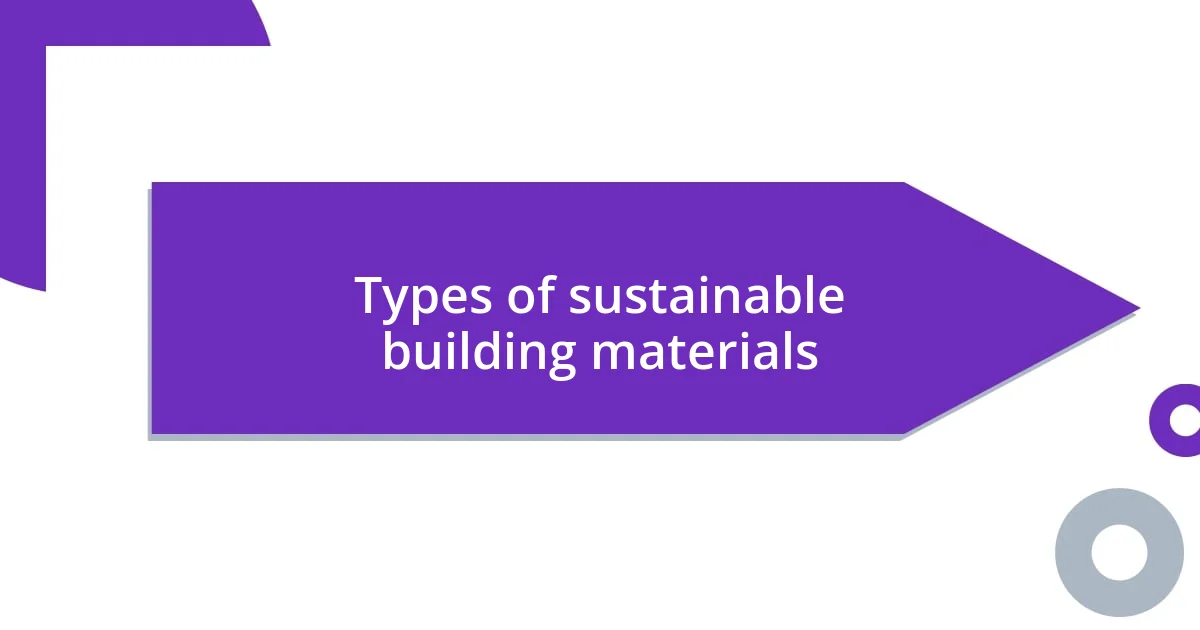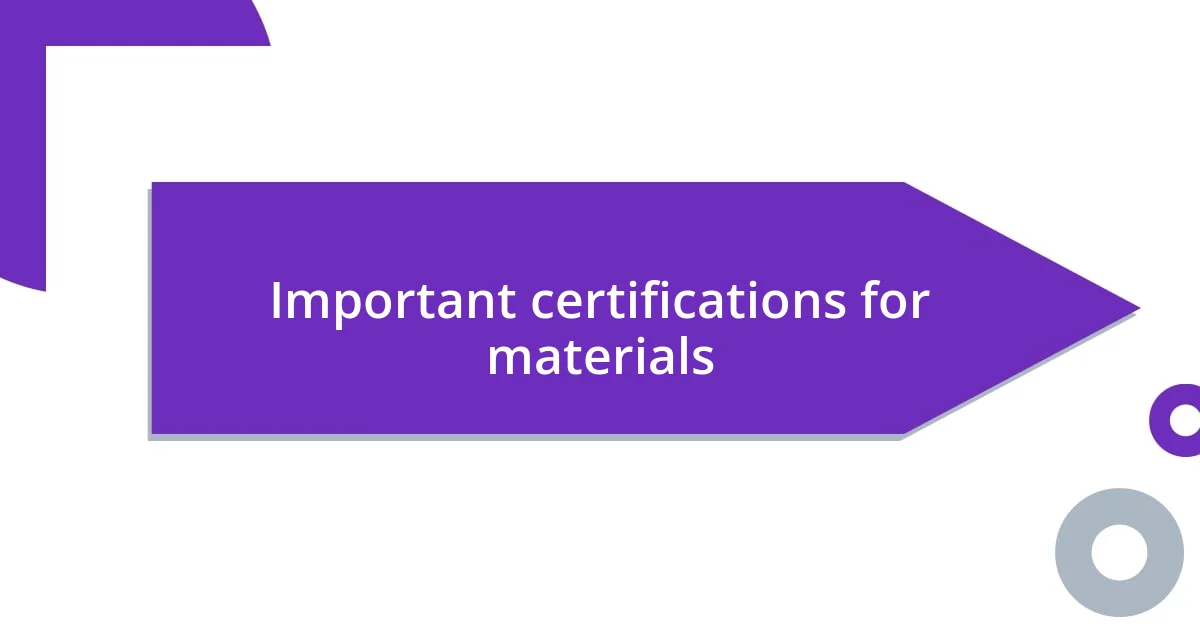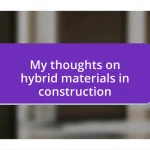Key takeaways:
- Eco-friendly materials, such as bamboo and reclaimed wood, enhance indoor air quality, reduce waste, and promote sustainability while contributing to personal well-being and a harmonious environment.
- Choosing sustainable building materials can lead to long-term cost savings, support local economies, and provide durability and longevity, despite higher initial investment costs.
- Understanding certifications like LEED, FSC, and ENERGY STAR helps ensure products are environmentally responsible, while collaborating with local suppliers and engaging in community initiatives can enhance sustainable building practices.

Understanding eco-friendly building materials
Eco-friendly building materials are designed to minimize environmental impact while promoting sustainability. I remember the first time I used bamboo flooring in my home; it felt both innovative and refreshing. This rapidly renewable resource is a perfect example of how smart material choices can lead to a healthier living space while supporting eco-conscious practices.
When I think about eco-friendly materials, I often reflect on the role of reclaimed wood. Have you ever seen a beautifully aged timber beam? There’s something profoundly satisfying about utilizing materials with a history, knowing you’re contributing to waste reduction and giving new life to something that was once discarded. It adds character to my space, and every mark tells a story.
Combining these materials isn’t just about functionality; it’s about creating a harmonious environment that resonates with our values. Choosing eco-friendly options can evoke a sense of peace and connection to nature. Have you considered how the materials in your surroundings affect your mood and well-being? I find that my choice of sustainable materials not only enhances the aesthetic of my home but also elevates my sense of responsibility toward our planet.

Benefits of eco-friendly materials
Opting for eco-friendly building materials often means choosing products that are healthier for our indoor environments. When I switched to low-VOC (volatile organic compounds) paints, I immediately noticed an improvement in air quality. There’s a certain relief in knowing that the walls of my home are not releasing harmful chemicals, which can lead to respiratory issues. Isn’t it reassuring to create a living space that promotes well-being?
Another benefit that stands out to me is the long-term cost-effectiveness of sustainable materials. Sure, the initial investment might be higher, but materials like recycled metal can last much longer than traditional options, saving money on replacements. I remember installing a green roof that not only enhanced the insulation of my home but significantly reduced energy bills. That type of financial relief is hard to overlook.
Lastly, using eco-friendly materials often contributes to local economies, as many sustainable options are sourced from local producers. I’ve discovered some amazing local artisans producing recycled glass countertops, and not only do they look stunning, but I also enjoy supporting my community. When I make purchases that bolster local businesses, it feels like I’m investing in a brighter future while enhancing my space in the process.
| Eco-Friendly Materials | Traditional Materials |
|---|---|
| Healthier indoor air quality | Potentially harmful VOCs released |
| Longer-lasting, cost-effective | Frequent replacement needed |
| Supports local economies | Often sourced globally |

Types of sustainable building materials
Sustainable building materials come in a variety of forms, each with unique benefits and characteristics. In my experience, one standout type is straw bales. When I helped a friend build her home with straw bale walls, I was astounded by their natural insulation properties and low environmental impact. The cozy warmth inside during winter was a direct testament to how effective and energy-efficient these materials can be.
Here’s a quick overview of some popular sustainable building materials that I’ve found particularly impressive:
- Bamboo: Fast-growing and highly renewable, perfect for flooring and furniture.
- Reclaimed Wood: Each piece tells a story and reduces waste while adding rustic charm to spaces.
- Recycled Steel: Strong, long-lasting, and infinitely recyclable, it’s excellent for framing and roofs.
- Hempcrete: A lightweight, insulating material made from hemp fibers, it offers a sustainable alternative to traditional concrete.
- Ram Earth: Made from natural clay, sand, and gravel, rammed earth walls are durable and efficient in regulating temperature.
Choosing these materials not only enhances the aesthetic of your space—it also connects you to a larger movement of responsible living. I still remember the pride I felt when I installed a recycled glass tile backsplash. Every shimmering piece reminded me that I was part of something bigger, contributing to a healthier planet while creating a stunning visual that sparked joy in my kitchen. There’s a true emotional fulfillment in merging beauty and sustainability in home design.

Important certifications for materials
When selecting eco-friendly building materials, understanding important certifications can really make a difference. I often turn to certifications like LEED (Leadership in Energy and Environmental Design) and Cradle to Cradle, which assess the sustainability and performance of products. Knowing that a product has been evaluated by a trusted third party gives me peace of mind; it’s like receiving a badge of honor, signifying its positive impact on the environment.
Another significant certification I’ve come across is the Forest Stewardship Council (FSC) label. This assures me that any wood I use comes from responsibly managed forests that provide environmental, social, and economic benefits. Recently, I sourced FSC-certified decking for my patio, and I felt a swell of pride in knowing I was helping sustain forest ecosystems while enhancing my outdoor space.
It’s also worth mentioning the ENERGY STAR certification, which identifies products that save energy and help reduce greenhouse gas emissions. The first time I replaced my old appliances with ENERGY STAR-certified ones, I was thrilled not only by the sleek designs but also by the reduction in my energy bill. Isn’t it satisfying to have a home that’s both stylish and eco-conscious?

How to choose materials effectively
When it comes to choosing materials effectively, I always begin with a clear purpose in mind. What do I want from my space? For example, I recently opted for reclaimed wood because I cherished its character and eco-friendliness. Each knot and imperfection tells a story, and knowing that I’m giving new life to something discarded truly resonates with me.
Next, I consider the material’s lifecycle. I remember the first time I used bamboo for flooring. It felt good to know that it grows back quickly, making it a sustainable option. But I also dig deeper, asking myself if it’s sourced responsibly. My research revealed the importance of asking questions about a product’s origins, ensuring it aligns with my values.
Lastly, I often weigh the practical aspects alongside emotional ones. Take my experience with hempcrete; it’s not just insulating and lightweight—it felt like a step toward healthier living. Imagining my family breathing cleaner air in a home built with sustainable materials gives me a sense of comfort that surpasses mere aesthetics. Isn’t it wonderful to make choices that nurture both our environment and our well-being?

Cost considerations for eco-friendly options
When considering the cost of eco-friendly materials, I’ve often discovered that the initial investment can be higher than traditional options. For example, I remember hesitating when I first considered solar panels for my roof. While the upfront price tag made me pause, I quickly realized that long-term savings on my energy bills and potential tax incentives could turn that cost into a smart investment.
It’s also important to think about the overall value these materials provide. When I chose recycled steel for my construction project, I was not just buying a product; I was investing in durability and reduced maintenance in the future. Does this mean I saved money down the line? Absolutely! It felt great to know I wasn’t skimping on quality while also being gentle on the planet.
What often surprises me is how eco-friendly choices can sometimes lead to hidden savings. After installing low-flow fixtures, my water bill decreased significantly. As I watched the numbers drop, I couldn’t help but think about how these small decisions add up over time. Do we really weigh the true cost of our choices? I believe understanding the long-term financial benefits can transform our perspective on what’s expensive and what’s truly worth it in the long run.

Tips for implementing sustainable practices
Implementing sustainable practices in building isn’t just about choosing the right materials; it’s about creating a mindset that embraces eco-friendliness every step of the way. One time, I started a home renovation project and made it a rule that every decision had to consider its environmental impact. Whether it was opting for energy-efficient appliances or ensuring my paint had low VOCs (volatile organic compounds), I found that putting sustainability at the forefront made my choices feel more meaningful. It was like a game-changer; it made me aware of how interconnected our decisions truly are.
I’ve learned that collaborating with local suppliers significantly benefits sustainable building. Not only do I reduce transportation emissions, but I also support my community. Last year, while building my garden shed, I sourced materials from a local mill. The conversation I had with the owner about their sustainable practices and commitment to the environment added so much value to the entire experience. It felt less like a transaction and more like joining forces with someone who shared my commitment to preserving the planet.
Every time I attend workshops or eco-focused events, I come away with fresh ideas for sustainable practices. Recently, I participated in a community forum about rainwater harvesting. It inspired me to implement a similar system at home, and I was surprised at how much water I was able to conserve! It’s these moments of inspiration that truly propel us forward. How about you? Have you been inspired to try something new or different in your sustainable endeavors? I believe that sharing these experiences not only empowers us but also encourages others on their journey toward eco-friendliness.














